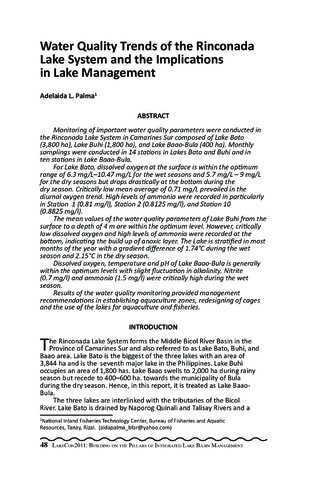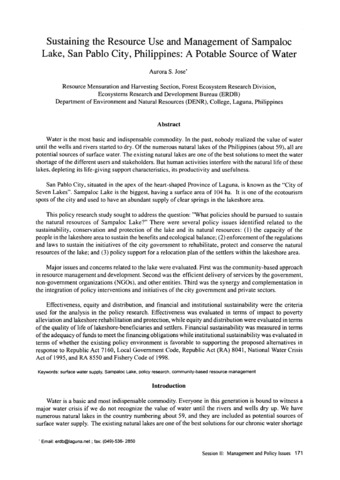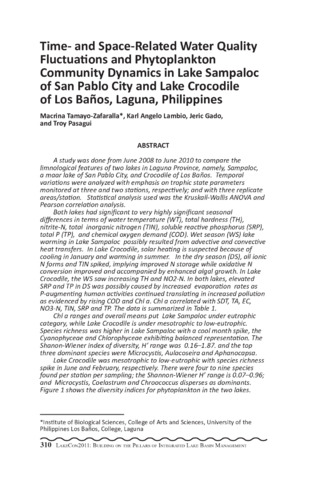Treating Laguna de Bay water to Philippine National Standards for drinking water with high-performance membranes
| dc.contributor.author | Wachinski, Anthony M. | |
| dc.contributor.editor | Aralar, Maria Lourdes C. | |
| dc.contributor.editor | Borja, Adelina S. | |
| dc.contributor.editor | Palma, Adelaida L. | |
| dc.contributor.editor | Mendoza, Marlynn M. | |
| dc.contributor.editor | Ocampo, Pablo C. | |
| dc.contributor.editor | Manalili, Eduardo V. | |
| dc.contributor.editor | Darvin, Loureeda C. | |
| dc.coverage.spatial | Bay, Laguna de | en |
| dc.date.accessioned | 2020-06-18T03:27:27Z | |
| dc.date.available | 2020-06-18T03:27:27Z | |
| dc.date.issued | 2013 | |
| dc.identifier.citation | Wachinski, A. M. (2013). Treating Laguna de Bay water to Philippine National Standards for drinking water with high-performance membranes. In M. L. C. Aralar, A. S. Borja, A. L. Palma, M. M. Mendoza, P. C. Ocampo, E. V. Manalili, & L. C. Darvin (Eds.), LakeCon2011: Building on the pillars of Integrated Lake Basin Management (Second National Congress on Philippine Lakes) (pp. 316-317). Los Baños, Laguna, Philippines: PCAARRD-DOST. | en |
| dc.identifier.issn | 1656-8099 | |
| dc.identifier.uri | http://hdl.handle.net/10862/5868 | |
| dc.description.abstract | The demand for reliable water supplies has been growing for years and is increasingly urgent in the Philippines. Using membrane technology, difficult-to-treat water sources are now viable water supply options. Hollow-fiber microfiltration (MF) membrane systems are especially effective in treating surface water supplies such as lakes, rivers, and reservoirs and are now used to supplement or to replace conventional water treatment technologies, e.g., rapid-mix, coagulation, sedimentation, and multimedia filtration. These low-pressure polymeric hollow-fiber membrane systems are used globally to treat surface and groundwaters for drinking water. High-quality drinking water (turbidity<0.1 NTU) can be assured by MF membranes, which effectively remove Cryptosporidium and Giardia and exceed United States EPA Surface Water Treatment Rule (SWTR) logremoval requirements. Hollow-fiber MF membrane systems made of the fluorocarbon polyvinylidenefluoride (PVDF) provide comprehensive oxidant compatibility that allows the oxidation and subsequent removal of iron and manganese. Taste and odor compounds are oxidized or removed by coagulants or powdered activated carbon. Automated integrity test procedures assure long-term membrane reliability. Low-pressure microfiltration technology is combined with reverse osmosis that removes dissolved solids caused by saltwater intrusion into the lake. This combined membrane system provides drinking water that surpasses the stringent water purity specifications of the Philippine National Standards for Drinking Water. Membrane systems can consistently produce drinking water with turbidity below 0.1 NTU, independent of feed water quality. This paper discusses design considerations for a custom-designed integrated membrane system combining hollow-fiber membrane technology with reverse osmosis to produce 100 million liters per day of potable and palatable drinking water (Fig.1). | en |
| dc.language.iso | en | en |
| dc.publisher | PCAARRD-DOST | en |
| dc.relation.ispartofseries | Summary of Proceedings No. 1/2013; | |
| dc.title | Treating Laguna de Bay water to Philippine National Standards for drinking water with high-performance membranes | en |
| dc.type | Conference paper | en |
| dc.citation.spage | 316 | en |
| dc.citation.epage | 317 | en |
| dc.citation.conferenceTitle | LakeCon2011: Building on the pillars of Integrated Lake Basin Management (Second National Congress on Philippine Lakes) | en |
| dc.subject.asfa | wastewater treatment | en |
| dc.subject.asfa | drinking water | en |
| dc.subject.asfa | water | en |
| dc.subject.asfa | water filtration | en |
| dc.subject.asfa | surface water | en |
| dc.subject.asfa | ground water | en |
| dc.subject.asfa | oxidation | en |
Files in this item
| Files | Size | Format | View |
|---|---|---|---|
|
There are no files associated with this item. |
|||
This item appears in the following Collection(s)
-
LakeCon2011 [30]
2nd National Congress on Philippine Lakes



